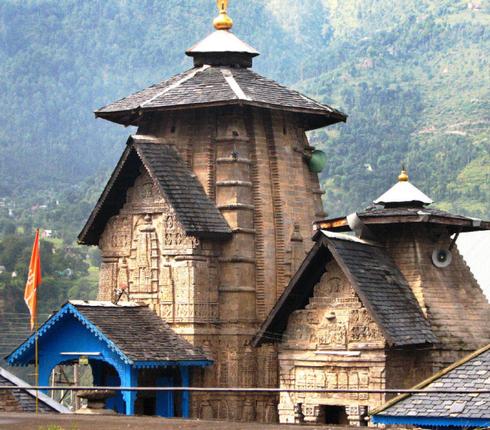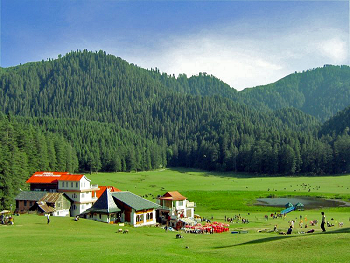|
Chamba valley is
known for it's magnificent scenery. This valley
touches the fringe of the Shivaliks and has three well-defined snowy
mountain ranges. These ranges are the Dauladhar or the outer Himalayas, the Pir Panjal or the mid Himalayas, and the Zanskar range or the inner Himalayas.
Chamba is situated at a height of 996 meters above
sea level on the south banks of the Ravi river.
Chamba, the ancient Pahari capital was founded in 920 AD by Raja Sahil Verma, who named it after his favorite daughter Champavati.
Chamba is bounded in the north-west by Jammu and
Kashmir, in the north-east and east by Ladakh, in
the south-east and south by Lahaul, Bara-Banga,
Kangra and Gurdaspur district of the Punjab. Chamba's serene beauty makes it the ideal holiday
retreat among various tourists and nature lovers. The various other adjoining places in Chamba
also offers immense scope for the leisure activities
to various visitors.
|
|
|
History of Chamba |
|
Chamba was founded not later than 600 AD and perhaps
as early as 550 AD. It was also believed that this
area was inhabited by certain Kolian tribes, who
were later, conquered by the Khasas who further were
ruled by the Audumbaras. From the 4th century AD,
Chamba was controlled by Thakurs and Ranas. With the
rise of Gurjara Pratiharas (7th century AD) the
Rajput Dynasties came to power. In 500 AD, a
legendry hero called Maru migrated to north-west
from Kalpagrama and founded Brahamputra in the
valley of the Budhal river. His successors continued
to rule from that capital city for over three
hundred years until Sahilla Varman shifted his
capital from Brahamputra to the more centrally
located plateau in the lower Ravi valley. He named
the town after his beloved daughter Champa. |
|
|
|
|
Fair and Festivals of Chamba |
 |
Some of the famous festivals celebrated in Chamba
are the Sui Mata Festival and Manimahesh Yatra. The
Sui Mata festival is the
Chamba's annual festival. This festival is celebrated in
the month of April for four days. This festival
commemorates Rani Champavati, the wife of the 10th
century Raja Sahil Verma. Only women and children
participate in the festival, dancing in the Chowgan
before processing with an image of Champavati.
The Manimahesh Yatra to the sacred tarn of
Manimahesh is held immediately after the festival of
Janamashtmi. In the month of August several places
in Chamba celebrates the Gugga fair, which is
connected with the worship of 'Gugga', the Nag Devta.
|
|
|
|
|
Crafts of Chamba |
|
The
main craft item of Chamba is the Chamba Rumal, known
for its unique embroidery style. The Chamba 'Rumal' or handkerchief
is about 2 to 6 feet in length. This embroidery done
on the handkerchief is also known as 'Kashida'.
In the embroidery the double satin stitch and the
stem stitch are used with the silk thread. This
embroidery was earlier practiced in the Chamba,
Bilaspur, Nurpur, Kangra, Basholi regions of
Himachal Pradesh. The rumals are not only known for
their rich aesthetic effect but also for the
significant subject matter.
|
|
|
|
|
Climate of Chamba |
|
The best time to visit Chamba is between the month
of April to October. As, during this time the climate is
neither too hot nor too cold. For the adventure lovers the
suitable month to visit Chamba is from November to March as
the mountains during this time are covered by snow and they
can reach the villages easily on the foot. It is advisable to
carry the woolens during winters.
|
|
| |
|
Tourist Attractions in Chamba |
|
The main tourist attraction in Chamba are the
temples. The Lakshmi Narayan temple is the main
temple of Chamba which is dedicated to the Lord
Vishnu. To the north of the palace at Chamba, there is a group of six stone Sikhara
temples arranged in a row from north to south. Close
to the royal palace at Chamba, there is a stone
Shikhara temple dedicated to Goddess Champavati. The main temples of Lakshmi Devi, Ganesh and Manimahesh and Nar Singh are known as Chaurashi temples.
Bhuri Singh Museum was opened on 14th September 1908
and was named after Raja Bhuri Singh.
|
 |
|
|
|
How to reach here: |
|
By Air:
The nearest airport is located at Gaggal, about 10
kms away from Kangra town on the Pathankot-Manali
highway.
By Rail:
The nearest railway station is located at Pathankot,
about 80 kms. Pathankot is connected with Jammu,
Delhi, Calcutta and Mumbai.
By
Road:
Chamba is connected to various important cities like
Delhi, Shimla, Manali, Dharamshala, Jammu and
various other cities.
|
|
|
|
|
|
|

